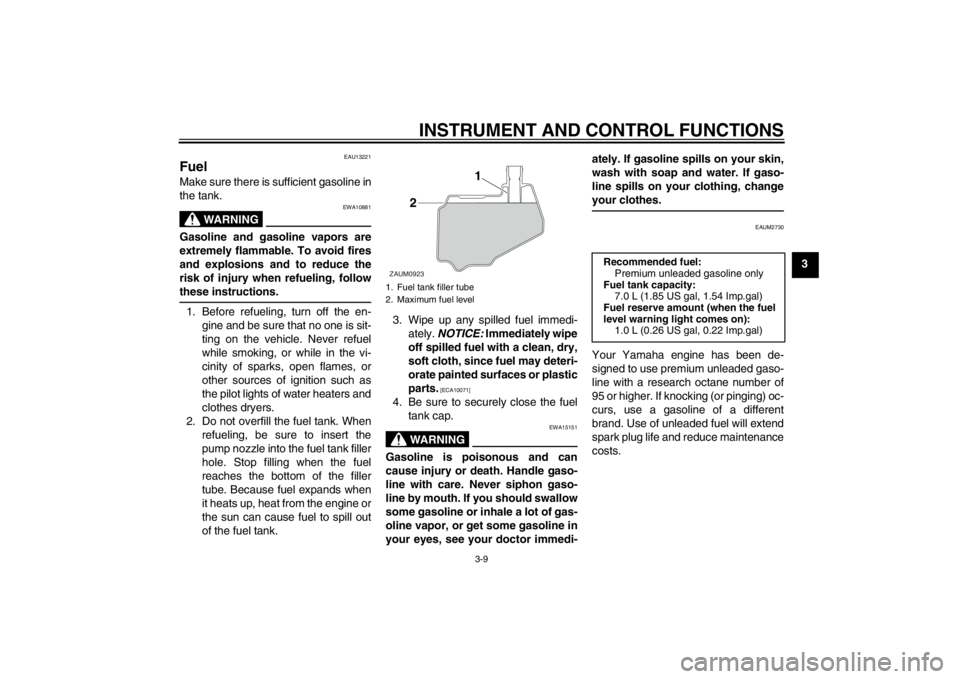2013 YAMAHA AEROX50 lights
[x] Cancel search: lightsPage 6 of 74

TABLE OF CONTENTSSAFETY INFORMATION ..................1-1
Further safe-riding points ................1-5
DESCRIPTION ..................................2-1
Left view ..........................................2-1
Right view ........................................2-2
Controls and instruments.................2-3
INSTRUMENT AND CONTROL
FUNCTIONS.......................................3-1
Main switch/steering lock ................3-1
Indicator lights and warning light ....3-2
Speedometer unit (NS50N) .............3-3
Multi-function display (NS50)...........3-4
Handlebar switches ........................3-6
Front brake lever ............................3-7
Rear brake lever .............................3-7
Fuel and 2-stroke engine oil tank
caps .............................................3-8
Fuel .................................................3-9
Catalytic converter ........................3-10
2-stroke engine oil ........................3-10
Kickstarter .....................................3-11
Seats ............................................3-11
Storage compartment ...................3-12
Adjusting the shock absorber
assembly (if equipped) ...............3-13FOR YOUR SAFETY –
PRE-OPERATION CHECKS............. 4-1
OPERATION AND IMPORTANT
RIDING POINTS................................. 5-1
Starting a cold engine .................... 5-1
Starting off ...................................... 5-2
Acceleration and deceleration ........ 5-2
Braking ........................................... 5-2
Tips for reducing fuel
consumption ............................... 5-3
Engine break-in .............................. 5-3
Parking ........................................... 5-4
PERIODIC MAINTENANCE AND
ADJUSTMENT................................... 6-1
Periodic maintenance chart for
the emission control system ....... 6-2
General maintenance and
lubrication chart .......................... 6-3
Removing and installing the cowling
and panel .................................... 6-6
Checking the spark plug ................. 6-7
Final transmission oil ...................... 6-8
Coolant ........................................... 6-9
Cleaning the air filter element ...... 6-10
Adjusting the carburetor ............... 6-11
Checking the throttle grip free
play ........................................... 6-11
Tires ............................................. 6-12
Cast wheels .................................. 6-14Checking the front and rear brake
lever free play ........................... 6-14
Checking the front and rear brake
pads .......................................... 6-15
Checking the brake fluid level ...... 6-15
Changing the brake fluid .............. 6-16
Checking and lubricating
the throttle grip and cable ......... 6-17
Lubricating the front and rear
brake levers .............................. 6-17
Checking and lubricating the
centerstand ............................... 6-17
Checking the front fork ................. 6-18
Checking the steering .................. 6-19
Checking the wheel bearings ....... 6-19
Battery ......................................... 6-19
Replacing the fuse ....................... 6-21
Replacing the headlight bulb ....... 6-22
Replacing the tail/brake light
bulb ........................................... 6-23
Replacing a turn signal light
bulb ........................................... 6-23
License plate light ........................ 6-24
Replacing the auxiliary light bulb
(if equipped) .............................. 6-24
Troubleshooting ........................... 6-25
Troubleshooting charts ................ 6-26
SCOOTER CARE AND STORAGE... 7-1
Matte color caution ........................ 7-1
Care ............................................... 7-1U1PHE0E0.book Page 1 Wednesday, August 29, 2012 4:42 PM
Page 11 of 74

SAFETY INFORMATION
1-4
1 Genuine Yamaha Accessories
Choosing accessories for your vehicle
is an important decision. Genuine
Yamaha accessories, which are avail-
able only from a Yamaha dealer, have
been designed, tested, and approved
by Yamaha for use on your vehicle.
Many companies with no connection to
Yamaha manufacture parts and acces-
sories or offer other modifications for
Yamaha vehicles. Yamaha is not in a
position to test the products that these
aftermarket companies produce.
Therefore, Yamaha can neither en-
dorse nor recommend the use of ac-
cessories not sold by Yamaha or
modifications not specifically recom-
mended by Yamaha, even if sold and
installed by a Yamaha dealer.
Aftermarket Parts, Accessories, and
Modifications
While you may find aftermarket prod-
ucts similar in design and quality to
genuine Yamaha accessories, recog-
nize that some aftermarket accessories
or modifications are not suitable be-
cause of potential safety hazards to you
or others. Installing aftermarket prod-ucts or having other modifications per-
formed to your vehicle that change any
of the vehicle’s design or operation
characteristics can put you and others
at greater risk of serious injury or death.
You are responsible for injuries related
to changes in the vehicle.
Keep the following guidelines in mind,
as well as those provided under “Load-
ing” when mounting accessories.
●
Never install accessories or carry
cargo that would impair the perfor-
mance of your scooter. Carefully
inspect the accessory before using
it to make sure that it does not in
any way reduce ground clearance
or cornering clearance, limit sus-
pension travel, steering travel or
control operation, or obscure lights
or reflectors.
Accessories fitted to the handle-
bar or the front fork area can
create instability due to improper
weight distribution or aerody-
namic changes. If accessories
are added to the handlebar or
front fork area, they must be as
lightweight as possible and
should be kept to a minimum. Bulky or large accessories may
seriously affect the stability of
the scooter due to aerodynamic
effects. Wind may attempt to lift
the scooter, or the scooter may
become unstable in cross
winds. These accessories may
also cause instability when
passing or being passed by
large vehicles.
Certain accessories can dis-
place the operator from his or
her normal riding position. This
improper position limits the free-
dom of movement of the opera-
tor and may limit control ability,
therefore, such accessories are
not recommended.
●
Use caution when adding electri-
cal accessories. If electrical acces-
sories exceed the capacity of the
scooter’s electrical system, an
electric failure could result, which
could cause a dangerous loss of
lights or engine power.
U1PHE0E0.book Page 4 Wednesday, August 29, 2012 4:42 PM
Page 18 of 74

INSTRUMENT AND CONTROL FUNCTIONS
3-2
3To unlock the steering
Push the key in, and then turn it to “ ”
while still pushing it.
EAU11006
Indicator lights and warning
light NS50
NS50N
EAU11020
Turn signal indicator light “ ”
This indicator light flashes when the
turn signal switch is pushed to the left or
right.
EAU11080
High beam indicator light “ ”
This indicator light comes on when the
high beam of the headlight is switched
on.
EAUM2771
Oil level warning light “ ”
This warning light comes on if the oil
level in the 2-stroke engine oil tank is
low during operation. If the warning
light comes on during operation, stop
immediately and fill the oil tank with Ya-
malube 2 or equivalent 2-stroke engine
oil of either JASO grade “FC” or ISO
grades “EG-C” or “EG-D”. The warning
light should go off after the 2-stroke en-
gine oil tank has been refilled.
The electrical circuit of the warning light
can be checked by turning the key
to “ ”. The warning light should come
on for a few seconds, and then go off.
1. Push.
2. Turn.
1. Coolant temperature warning light “ ”
2. High beam indicator light “ ”
3. Turn signal indicator light “ ”
4. Fuel level warning light “ ”
5. Oil level warning light “ ”ZAUM0908
12
3
4
5
ZAUM0957
3
45
2
1
U1PHE0E0.book Page 2 Wednesday, August 29, 2012 4:42 PM
Page 20 of 74

INSTRUMENT AND CONTROL FUNCTIONS
3-4
3
EAUM2821
Multi-function display (NS50)TIPThe multi-function display performs the
following self-test for three seconds in
order to check the electrical circuit.●
The speedometer digits display
from 0 to 80, and then from 80 to 0
in kilometers. If the speedometer is
set to miles, the digits will display
from 0 to 50, and then from 50 to 0.
●
All LCD segments and warning
lights come on and then go off.
WARNING
EWA12312
Be sure to stop the vehicle before
making any setting changes to the
multi-function display. Changing
settings while riding can distract the
operator and increase the risk of an
accident.The multi-function display is equipped
with the following:●
a digital clock
●
a digital speedometer (which
shows riding speed)
●
an odometer (which shows the to-
tal distance traveled)
●
a tripmeter (which shows the dis-
tance traveled since it was last set
to zero)
●
a fuel reserve tripmeter (which
shows the distance traveled on the
fuel reserve)
●
a fuel gauge
●
a self-diagnosis device
TIP●
Be sure to turn the key to “ ” be-
fore using the “RESET/SELECT”
button.
●
For the U.K. only: To switch the
speedometer and odometer/trip-
meter displays between kilometers
and miles, when the main switch is
turned to “ ”, press the “RE-
SET/SELECT” button for at least
eight seconds.
To set the clock:1. Select the odometer and push the
“RESET/SELECT” button for at
least three seconds.
2. When the hour digits start flashing,
push the “RESET/SELECT” button
to set the hours.
3. To change the minutes digits, push
the “RESET/SELECT” button for
at least three seconds.
1. Speedometer
2. Clock
3. “RESET/SELECT” button
4. Odometer/tripmeters/fuel reserve tripmeter
5. Fuel gaugeZAUM0911
1
2
34
5
ZAUM0912
U1PHE0E0.book Page 4 Wednesday, August 29, 2012 4:42 PM
Page 23 of 74

INSTRUMENT AND CONTROL FUNCTIONS
3-7
3
EAU12400
Dimmer switch “ / ”
Set this switch to “ ” for the high
beam and to “ ” for the low beam.
EAU12460
Turn signal switch “ / ”
To signal a right-hand turn, push this
switch to “ ”. To signal a left-hand
turn, push this switch to “ ”. When re-
leased, the switch returns to the center
position. To cancel the turn signal
lights, push the switch in after it has re-
turned to the center position.
EAU12500
Horn switch “ ”
Press this switch to sound the horn.
EAUM1132
Start switch “ ”
Push this switch while applying the
front or rear brake to crank the engine
with the starter. See page 5-1 for start-
ing instructions prior to starting the en-
gine.
EAU12901
Front brake lever The front brake lever is located on the
right side of the handlebar. To apply the
front brake, pull this lever toward the
throttle grip.
EAU12951
Rear brake lever The rear brake lever is located on the
left side of the handlebar. To apply the
rear brake, pull this lever toward the
handlebar grip.
1. Front brake lever
1
ZAUM0791
1. Rear brake lever
1
ZAUM0085
U1PHE0E0.book Page 7 Wednesday, August 29, 2012 4:42 PM
Page 25 of 74

INSTRUMENT AND CONTROL FUNCTIONS
3-9
3
EAU13221
Fuel Make sure there is sufficient gasoline in
the tank.
WARNING
EWA10881
Gasoline and gasoline vapors are
extremely flammable. To avoid fires
and explosions and to reduce the
risk of injury when refueling, follow
these instructions.1. Before refueling, turn off the en-
gine and be sure that no one is sit-
ting on the vehicle. Never refuel
while smoking, or while in the vi-
cinity of sparks, open flames, or
other sources of ignition such as
the pilot lights of water heaters and
clothes dryers.
2. Do not overfill the fuel tank. When
refueling, be sure to insert the
pump nozzle into the fuel tank filler
hole. Stop filling when the fuel
reaches the bottom of the filler
tube. Because fuel expands when
it heats up, heat from the engine or
the sun can cause fuel to spill out
of the fuel tank.3. Wipe up any spilled fuel immedi-
ately. NOTICE: Immediately wipe
off spilled fuel with a clean, dry,
soft cloth, since fuel may deteri-
orate painted surfaces or plastic
parts.
[ECA10071]
4. Be sure to securely close the fuel
tank cap.
WARNING
EWA15151
Gasoline is poisonous and can
cause injury or death. Handle gaso-
line with care. Never siphon gaso-
line by mouth. If you should swallow
some gasoline or inhale a lot of gas-
oline vapor, or get some gasoline in
your eyes, see your doctor immedi-ately. If gasoline spills on your skin,
wash with soap and water. If gaso-
line spills on your clothing, change
your clothes.
EAUM2730
Your Yamaha engine has been de-
signed to use premium unleaded gaso-
line with a research octane number of
95 or higher. If knocking (or pinging) oc-
curs, use a gasoline of a different
brand. Use of unleaded fuel will extend
spark plug life and reduce maintenance
costs.
1. Fuel tank filler tube
2. Maximum fuel levelZAUM0923
1
2
Recommended fuel:
Premium unleaded gasoline only
Fuel tank capacity:
7.0 L (1.85 US gal, 1.54 Imp.gal)
Fuel reserve amount (when the fuel
level warning light comes on):
1.0 L (0.26 US gal, 0.22 Imp.gal)
U1PHE0E0.book Page 9 Wednesday, August 29, 2012 4:42 PM
Page 32 of 74

FOR YOUR SAFETY – PRE-OPERATION CHECKS
4-2
4
Rear brake Check operation.
If soft or spongy, have Yamaha dealer bleed hydraulic system.
Check brake pads for wear.
Replace if necessary.
Check fluid level in reservoir.
If necessary, add specified brake fluid to specified level.
Check hydraulic system for leakage.6-14, 6-15, 6-15
Throttle grip Make sure that operation is smooth.
Check throttle grip free play.
If necessary, have Yamaha dealer adjust throttle grip free play and lubricate cable
and grip housing.6-11, 6-17
Wheels and tires Check for damage.
Check tire condition and tread depth.
Check air pressure.
Correct if necessary.6-12, 6-14
Brake levers Make sure that operation is smooth.
Lubricate lever pivoting points if necessary.6-17
Centerstand Make sure that operation is smooth.
Lubricate pivot if necessary.6-17
Chassis fasteners Make sure that all nuts, bolts and screws are properly tightened.
Tighten if necessary.—
Instruments, lights, signals
and switches Check operation.
Correct if necessary.—
Battery Check fluid level.
Fill with distilled water if necessary.6-19 ITEM CHECKS PAGE
U1PHE0E0.book Page 2 Wednesday, August 29, 2012 4:42 PM
Page 35 of 74

OPERATION AND IMPORTANT RIDING POINTS
5-3
5
EAU16820
Tips for reducing fuel con-
sumption Fuel consumption depends largely on
your riding style. Consider the following
tips to reduce fuel consumption:●
Avoid high engine speeds during
acceleration.
●
Avoid high engine speeds with no
load on the engine.
●
Turn the engine off instead of let-
ting it idle for an extended length of
time (e.g., in traffic jams, at traffic
lights or at railroad crossings).
EAU16830
Engine break-in There is never a more important period
in the life of your engine than the period
between 0 and 1000 km (600 mi). For
this reason, you should read the follow-
ing material carefully.
Since the engine is brand new, do not
put an excessive load on it for the first
1000 km (600 mi). The various parts in
the engine wear and polish themselves
to the correct operating clearances.
During this period, prolonged full-throt-
tle operation or any condition that might
result in engine overheating must be
avoided.
EAUM2091
0–150 km (0–90 mi)
Avoid prolonged operation above 1/3
throttle. Vary the speed of the scooter
from time to time. Do not operate it at
one set throttle position.
150–500 km (90–300 mi)
Avoid prolonged operation above 1/2
throttle.
500–1000 km (300–600 mi)
Avoid cruising speeds in excess of 3/4
throttle.
ZAUM0269
U1PHE0E0.book Page 3 Wednesday, August 29, 2012 4:42 PM